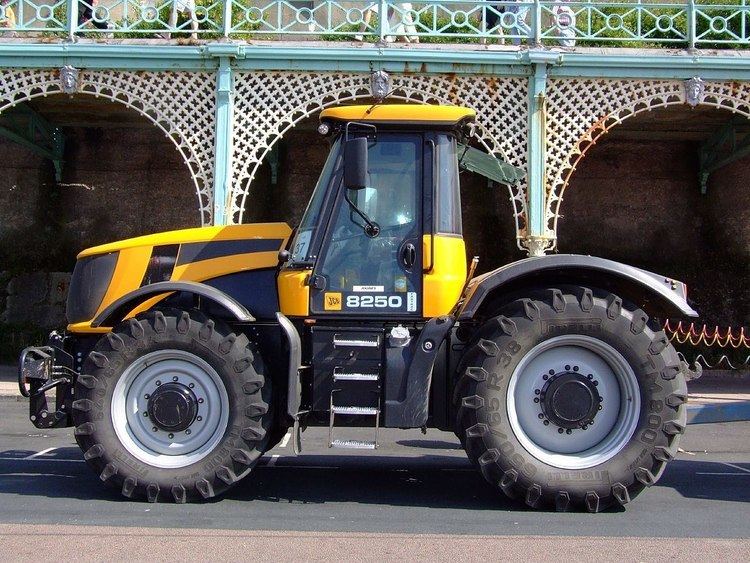 | ||
The JCB Fastrac is a high speed agricultural tractor series manufactured by JCB Landpower, part of the J. C. Bamford group of companies.
Contents
- Engine
- Gearbox
- Four wheel drive
- Axles
- Axle locking differentials
- PTO
- Suspension
- Front axle steering
- Rear axle steering
- Brakes
- Auxiliary hydraulics
- Three point hitch
- Rear trailer hitch
- Cab
- Models produced
- Feature in media
- References
Production began in 1991, with continual development to the present day. Generally the maximum speed of most models is 65 km/h (40 mph) but other speeds both slower (40 km/h) and faster (80 km/h) are produced.
Engine
All models have six cylinder diesel engines. Initially supplied by Perkins Engines then Cummins, the current suppliers are AGCO SISU Power.
Gearbox
Three different gearboxes have been fitted to the Fastrac in production.
- On introduction of the Fastrac this style of gearbox had 18 forward gears (6x3) and 6 reverse (6x1). This were organised as 6 manual gears in each of 3 ranges (Low, Medium and High). The range box also selected reverse giving 6 reverse gears with speeds similar to medium in forwards. All gear changes were made with the use of a dry clutch.
- This gearbox then had a 2 speed powershift section added after the dry clutch and before the 6 speed gearbox. This resulted in 36 forward gears (2x6x3) and 12 reverse (2x6x1).
- Following this the 2 speed powershift section was changed to 3 speed version. Giving 54 forward gears (3x6x3) and 18 reverse gears (3x6x1)
- The latest version of this gearbox a wet clutch replaced the dry clutch still with 54 forward and 18 reverse gears.
Four wheel drive
All models are selectable four-wheel drive. The rear axle is driven as standard and drive to the front axle selected by the driver, through a hydraulically controlled clutch. This clutch is sprung on to give four wheel drive and hydraulically disengaged to give two wheel drive.
Axles
Most Fastrac axles have a central differential and epicyclic gearing reduction units built into the hub ends, where the wheel bolts.
The 7000 Series rear axle has a central differential and has in-board epicyclic gearing reduction units.
Axle locking differentials
A standard locking differential is provided in the rear axle of all machines.
100, 1000, 2000 and 4000 Series machines have a Detroit No-Spin style differential lock in front axle.
3000, 7000 and 8000 Series machines have a driver controlled clutch pack engaged locking differential.
PTO
A two speed power take-off (PTO) is standard at the rear and a factory option at the front. Depending on the model either speeds of 1000/540 or 1000/750 are available.
Suspension
Multi link suspension (suspension) is fitted between the chassis and both the front and rear beam axles.
The front suspension on most machines uses four links, a panhard rod and anti-roll bar. On the 4000 series a V-link is used at the front.
The rear suspension uses two lower link and a V-link on top plus an anti-roll bar.
Hydropneumatic suspension is used on the rear of all models and on the front of the 4000 and 7000 series Fastrac. This is similar to that used on some Citroen cars.
Front axle steering
These Fastrac machines have hydrostatic steering similar to most agricultural tractors with only a hydraulic link between the steering wheels and the front wheels. This limits the maximum speed of these models to 50 km/h (31 mph), except now in Germany where 60 km/h (37 mph) is allowed.
These machines have mechanical power steering similar to a large truck. This system gives a mechanical link between the steering wheel and the front wheels. Generally these machines have had a maximum speed of 65 km/h (40 mph) except some 100 and 3000 series machines having a maximum speed of 75 km/h (47 mph).
These machines have dual circuit hydrostatic steering allow legal speeds over 60 kph.
An automatic GPS controlled steering system using a (Differential Global Positioning System) is available for the 3000, 4000, 7000 and 8000 series machines.
Rear axle steering
Rear wheel steering (four wheel steering) is available as an option on 2000 and 4000 series machines. The electronic system has 5 modes of operation, and only allows four wheel steering below 20 km/h (12 mph).
Brakes
All models are fitted with large diameter external disc brakes at both front and rear individually on each wheel. An anti-lock braking (ABS) system is fitted on some models, depending on the maximum vehicle speed and legal requirements.
Auxiliary hydraulics
An auxiliary hydraulic system (hydraulic drive system) is standard on all machines. It is used to control the front and rear linkages and through quick connectors at the front and rear of the tractor to control and power implements.
Three-point hitch
A three-point hitch is standard at the rear of the machine and on option on front.
Rear trailer hitch
There are several types available depending on the country the machine is built for.
Cab
Traditionally the cab has been centrally mounted. Some models, the 7000 series and latter 8250, have the cab mounted at the rear of the tractor. The most recent fastrac iteration, the 4000 series tractors, have forward sloping cabs,similar to those on combine harvesters. All cabs have a full size passenger seat and an air suspensioned driver's seat
Models produced
This is not intended to be a complete list but includes the main models produced.
Feature in media
A JCB Fastrac was chosen by BBC's Top Gear host Jeremy Clarkson. It was driven on the show round the Top Gear Test Track by The Stig, in a time of 2:57.4, making it the fastest of the three featured tractors, but also currently the fifth slowest ever lap time.
A JCB Fastrac appeared in news coverage of the JCB Dieselmax land speed record car, pushing it to its 30 mph starting speed.
